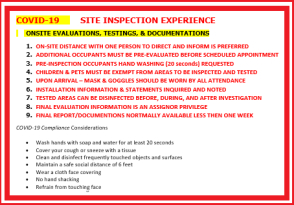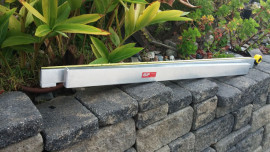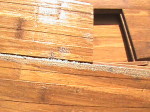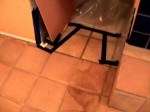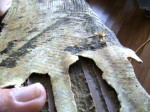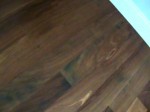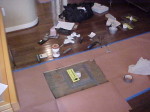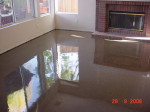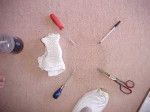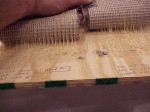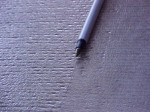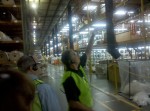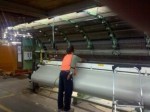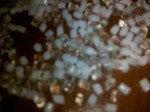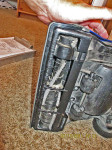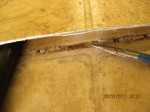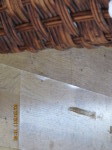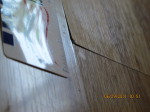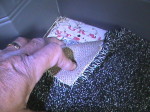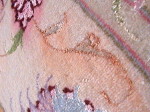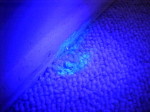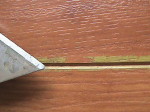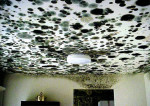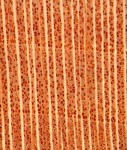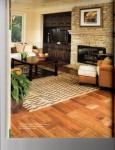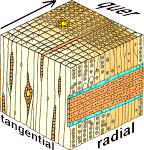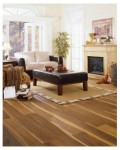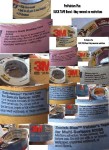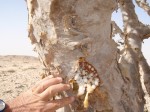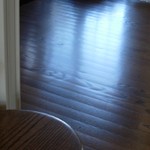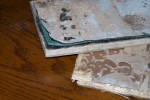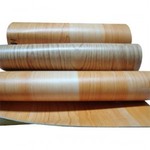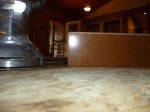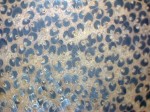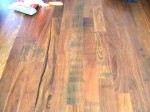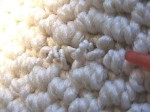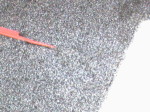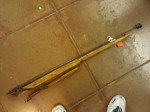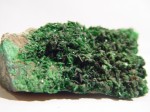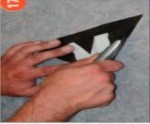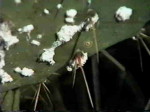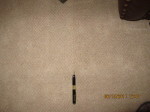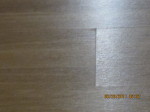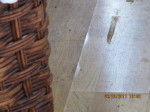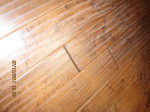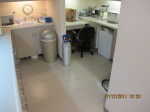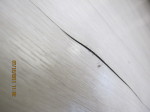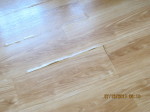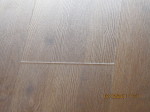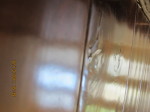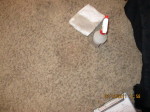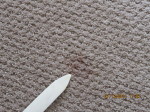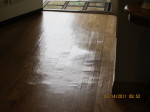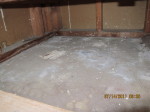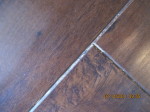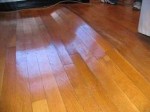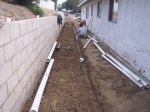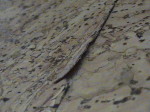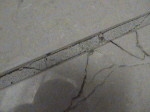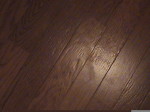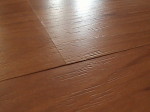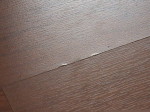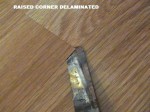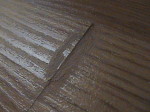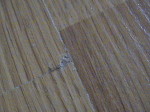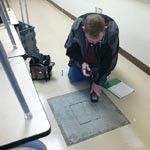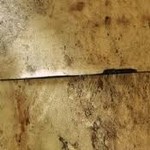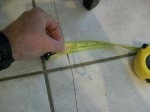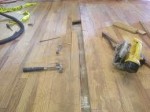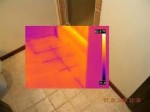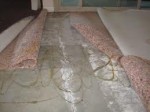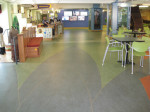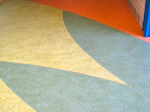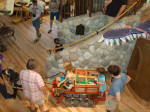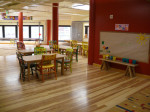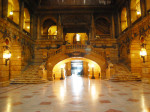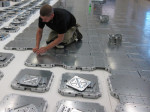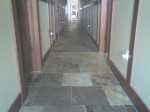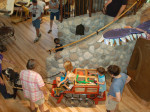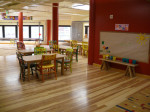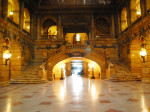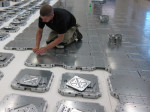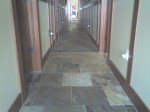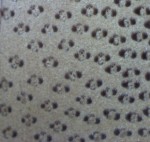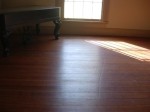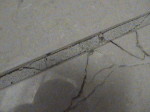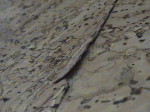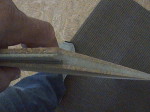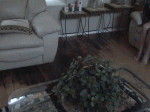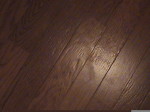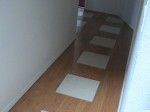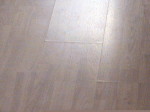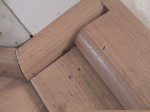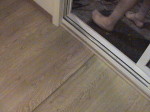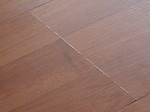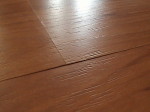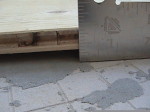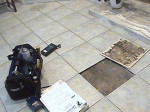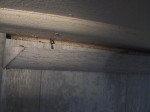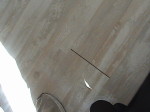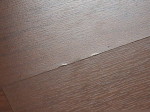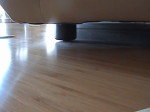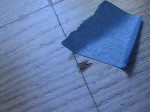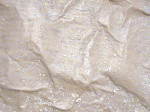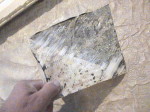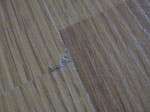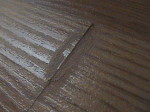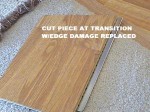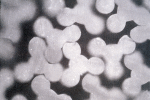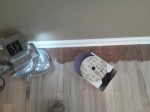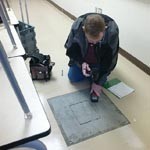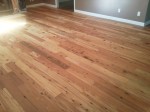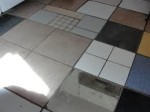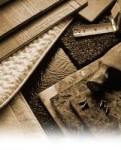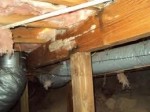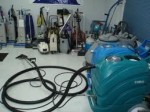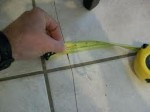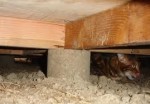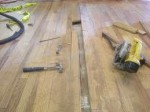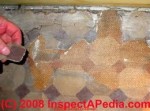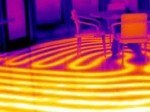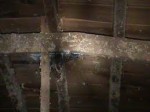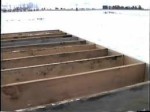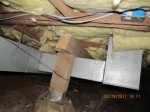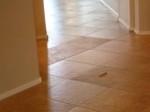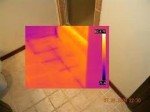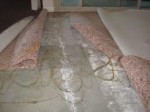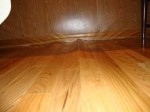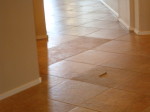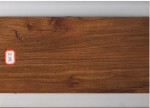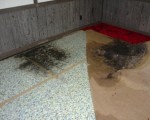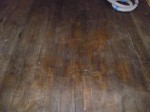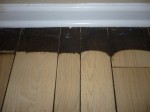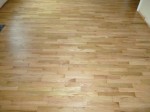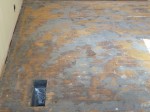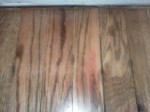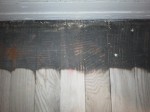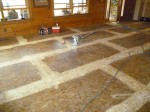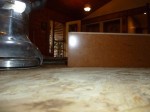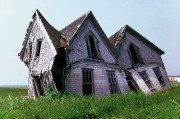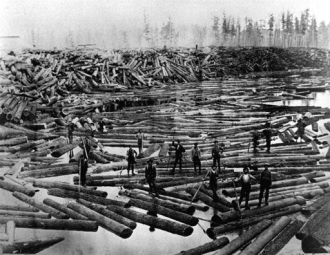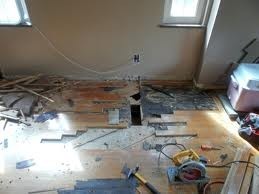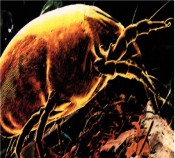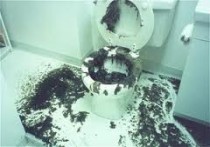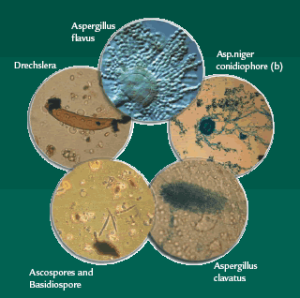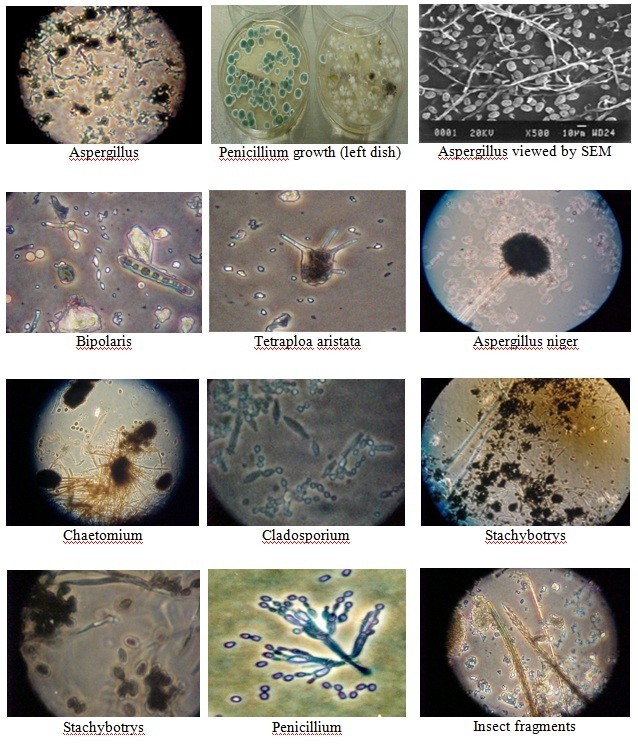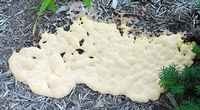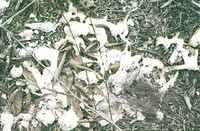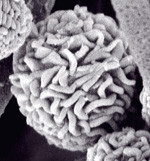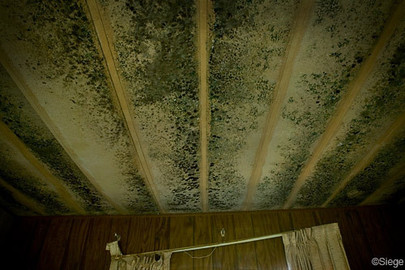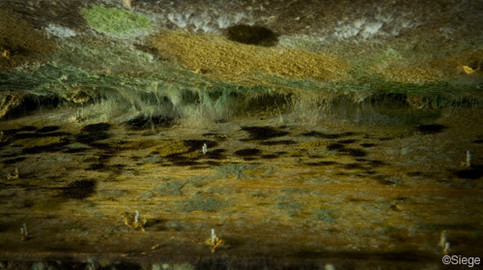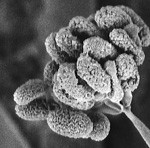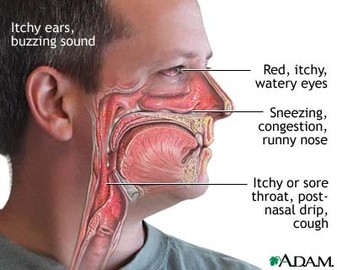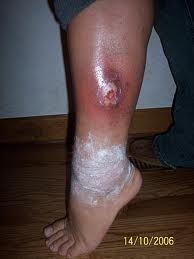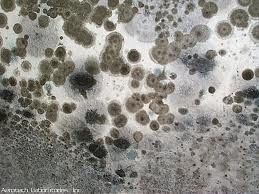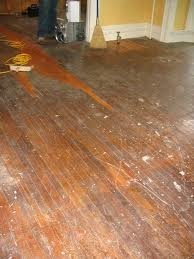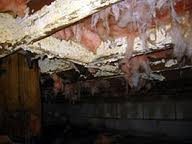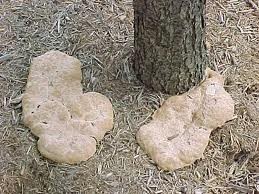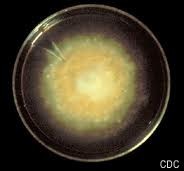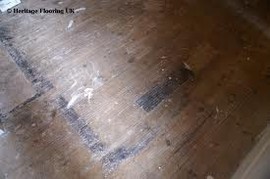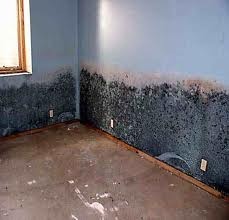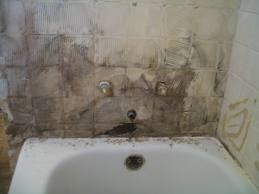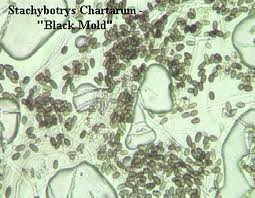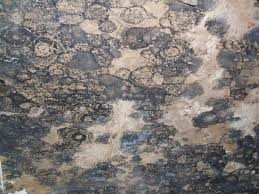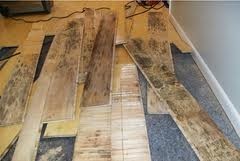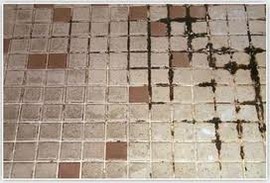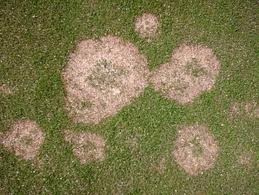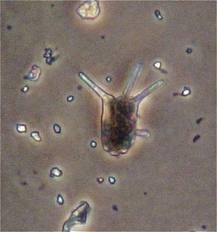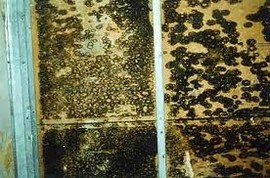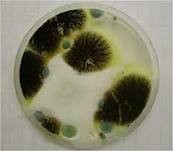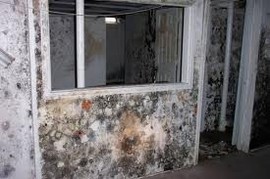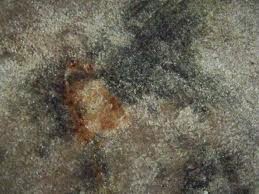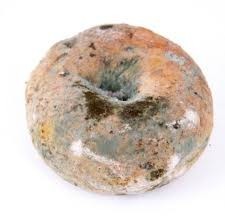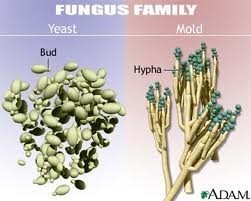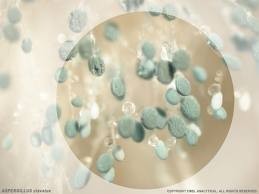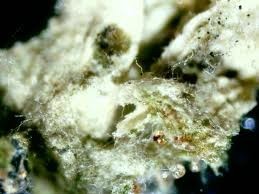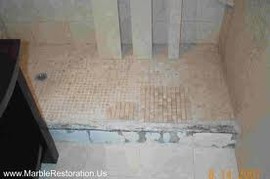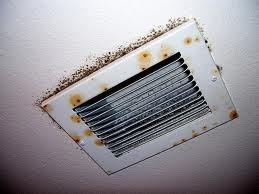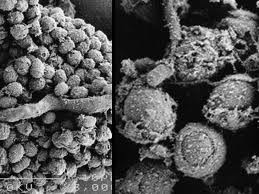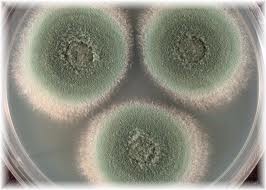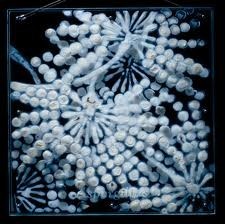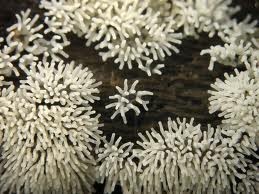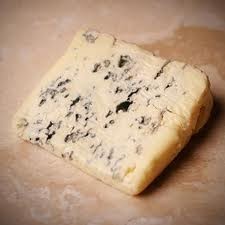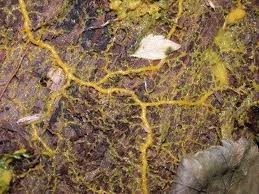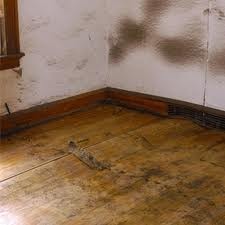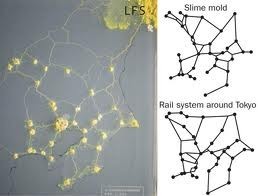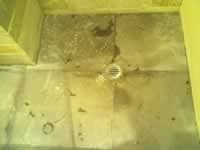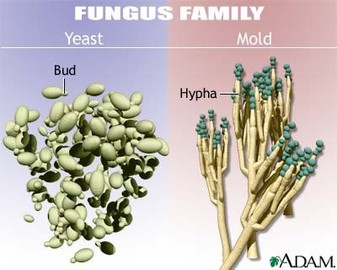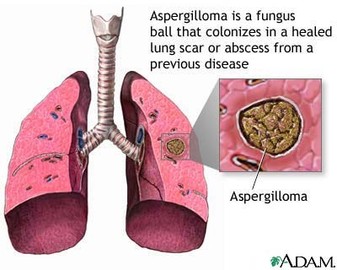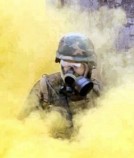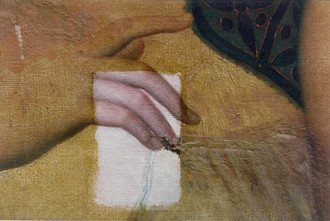RESTORATION
CONTENTS BELOW INCLUDE:
- WATER LOGGED FLOORS
- REPAIRING WATER-DAMAGED WOOD FLOORS
- ANTI-ALLERGEN CLEANING
- FLEAS & BEETLES
- MOLD TOXINS, EXPOSURE LIMITS AND TESTING/EVALUATION
- TEAR GAS CLEANUP PROCEDURES
- PADS AND BRUSHES
- A NEW BREED OF RESTORERS
QUESTIONS EMAIL TO: floorcovering@cox.net
1. WATER LOGGED FLOORS
When disaster strikes, you don't necessarily have to throw out the wood floor with the bath water. Sometimes all it takes is a mop, a fan and a moisture meter-and time. As a hardwood flooring professional, you have control over the entire installation process. Assuming the proper materials, tools, talent and job-site conditions, nothing can stand in your way. Comes a hurricane, though, and all your hard work can be reduced to—or rather, can expand into—a tangle of twisted, sodden strips. It doesn't even have to be anything as exotic as a tsunami. A leaky roof and the resulting spill can spoil a surface if the puddles of rainwater aren't removed quickly.
Fortunately, these kinds of troubles might only visit one out of every 20 floors, or 50—but complacency is not called for. Even at a 5 or 2 percent disaster rate, the average contractor will face this situation many times in a lifetime of hardwood work. Water, water everywhere
The steps taken in response to water damage depend on the type of flooring system, the extent of the problem and the part of the world where it occurs. In cities like New York, for example, the relatively low price of replacement makes undertaking a salvaging operation a questionable pursuit. Irene Jablonski.president of Nick Olson's Maintenance Supplies Ltd. in Richmond Hill , N.Y., estimates that removal of damaged wood
occurs 90 percent of the time in her area. "In California." she says, "where hardwood flooring costs three times as much per square foot, you'll find they have a very different outlook on these problems."
The flooring type is another variable. Floors glued directly to concrete slab don't allow water as easy access to the subfloor as do floating floors. The quality of adhesives has improved greatly over the years, so that even in the case of major damage, a glue-down floor can
remain stable and be nearly as good as new after drying out. Sandy Wilson, who heads up the hardwood division of R.L. Dresser Inc. in Raleigh, N.C.. remembers seeing a gym floor emerge almost completely unscathed after a flood.
"I've never seen anything like it," Wilson says. "This floor was actually underwater, and because of the holding power of the polyurethane adhesive, the floor never left the concrete. Half the floor was underwater for a weekend, and it took about three months, but they were able to dry it out. and we just went back in and sanded the floor and they never had to replace but a slat or two in the whole surface."
Wilson's company specializes in hardwood flooring for recreational facilities, so he's seen more than his share of damaged gym floors, from leaky roofs to possible sabotage to Hurricane Hugo. "Most sports facilities have maple floors." Wilson says. "Some go down over plywood, or sleepers, or a combination of both, and some utilize floating systems. Sometimes water gets beneath these types of floors, and very often it's hard to tell to what extent the floor's been affected from below by looking at it from above. In those cases you have to remove some of the finished floor to see if the water's trapped under there. It's a wait-and-see process. Basically, you remove flooring until you hit dry material and then lace it back in and repair it." The other major variable is the amount of water on the floor—and the amount of time it takes to have it removed. Dealt with quickly, surface moisture that comes from a roof leak or a major spill may only lead to slight cupping, in which case minor repairs will be all that's needed.
Dry your eyes. All flooded floors must be dried as quickly as possible to prevent water from soaking in. The drying process can be
a simple one, accomplished with basic household tools such as a wet/dry vacuum cleaner, mops and surface fans. If time isn't a huge factor, that's all that's absolutely necessary, although the use of a moisture meter to check both above and below the floor before repairs are begun is highly recommended. Mother Nature can be helped along by turning on a little heat in the building. But in cases where speed is really vital, companies do exist whose sole purpose is aiding and abetting the process of evaporation. Orlando Ojeda, of Moisture Removal Technologies in Atlanta, says that in cases of extreme humidity, mere surface fans do little except re-circulate humid air. "We use large dehumidification systems," Ojeda says. "The process is like a hair dryer; we drop the relative humidity and then pump forced hot air over the surface. If you drop the humidity below 50 percent, you can dry out an environment faster." Again, floating floors give repair work an added dimension. "We were installing the floor in the 'Dean Dome.' " says Wilson, referring to the home of Dean Smith's University of North Carolina Tarheels. "It's a 16,000-square-foot spring-air floor, and somebody late one Friday afternoon left a hose running—maybe it was sabotage —and it ran down a ramp over a couple of days. Of course, the floor was up on springs, so the water had a chance to run way underneath the floor. We had to jack the floor up, get fans in there and dry it all out. Fortunately, it wasn't sanded or finished yet—but we did have to replace about 1,000 square feet of flooring." You'll only be able to adequately assess what will need to be repaired after the floor is completely dry, above and below. When wet, your wood took on water, expanded, and cupping occurred. Quite possibly, the swollen wood hit the wall, causing the floor to buckle. Once dry, the swelling may have subsided leaving cracks between the boards. Often, though, a waterlogged floor may only show one of these symptoms. If it's cupped wood, a small amount of spot-sanding can do the trick. Any cracks that have opened as the flooring has dried can be filled, and the affected area re-finished. To help the damaged parts blend in, it may be necessary (or desirable) to re-sand and finish the whole floor, as many finishes amber over time, making matching shades difficult. "If you've got a good man who knows what he's doing." says Wilson, "the floor can be just as attractive afterward." A buckled floor can be more difficult to repair. Sometimes the floor will drop back down after drying, but there are occasions where the wood will fill the expansion gap around the floor's perimeter and become jammed into the walls. One way to deal with this. Wilson says, is to recreate the original expansion gap at the wall line, cither by removing a board or by cutting a new expansion gap. The resulting space can then be covered up with a metal angle (in the case of a gym floor) or baseboard. Whether a home or gym owner decides to attempt a repair of a damaged floor or succumbs to the urge to start over again will depend on the importance of time more often than on the cost differential. A high percentage of hardwood floors are insured against damage, and very many hardwood floor owners will opt, at least at first, to fully replace the floor in the belief that only replacement will undo what nature (or fate) has wrought. That, however, is a mistaken belief. Given the right tools and a little talent, repairing a damaged floor can be a viable option.
2. REPAIRING WATER-DAMAGED WOOD FLOORS
Wet and Wild:
Repairing Water-Damaged Wood Floors
The products of the hardwood flooring industry have long been prized for their structural integrity and capacity for restoration, should the need arise. Hardwood floors are significantly unique not only because of their natural origins, but because of their truly redeeming qualities. As is true of any floor covering, mishaps can mar the installation during the course of its lifespan. But one of the principal reasons why todays consumers choose hardwood for their new homes, or as a. replacement for an existing floor covering, is the product's longevity and capacity for renewal. Believe it or not, most of these same consumers espouse the idea that wood floors which have been exposed to a source of uncontrolled water will require complete replacement because of the disfiguration that results. Obviously, the amount of water exposure, the gross square footage of the affected portion of the floor and —most of all — the duration of the exposure ultimately determine the repair and restoration procedure required for the floor. The homeowner may require some reassuring "hand holding" from the dealer/contractor during restoration work.
It's also important to inform homeowners of the personal contribution they'll be required to make during the process. Your challenge is to overcome their narrow focus on making this temporary problem go away as soon as possible. Homeowners need to be convinced that an integral part of the restoration process requires waiting for the floor to completely dry and stabilize to it, the original moisture content. Their patience
and understanding of this requirement is vital to the ultimate success of the restoration procedure.
Stabilization of the material and environment has always been a prerequisite for hardwood installations. Before an original installation can proceed, the wood flooring must be acclimated to the jobsite environment. This rule still applies in a restoration situation. When it comes to dealing with a hardwood floor that's been exposed to excess moisture, arresting and stabilizing the undesirable condition will require the dealer/contractor to conduct a fact-finding mission to locate me source of the problem. In new residential construction, obvious sources of moisture indoors — such as a leak from the roof or a break in a plumbing supply line to a fixture — are normally detected and corrected before the hardwood flooring dealer/con tractor arrives on die scene to install his products. When moisture affects the floor after installation, the homeowner may view your follow-up inspection report and findings with skepticism. Many will express the opinion that something other than the floor is all wet— namely, your report. Seasonal Moisture-Content Fluctuations In Wood Floors — Cupping, crowning and gapping between wood floor strips/planks typically is caused by moisture content-fluctuations in the product, usually the result of seasonal environmental changes or exposure to a hidden source of moisture. In the pairs of figures on the map, the first represents the average January percentage of moisture content in wood products used indoors, while the second expresses the products' average moisture content in July. Source: U.S. Department of Agriculture, Forest Products Laboratory.
Convincing the customer that a moisture-related problem can and will exist —even in the absence of a raging river running through a portion of the hardwood floor installation — may constitute a challenge in itself. Most homeowners tend to think that the hardwood product is defective whenever the source of moisture isn't obvious or easily detected. In such situations, your best defense is a quiet offense. Utilize your silent partner, the moisture meter. By taking several moisture readings throughout the installation, you can document any and all areas in the floor that are beyond the accepted industry standards for allowable moisture content. In most cases, you can show the homeowner the numerical readings displayed on the moisture meter and demonstrate how they decrease as you move further away from the moisture's source. The most common moisture-generating culprits include exterior doors, usually in need of threshold repairs or replacement, that occasionally allow wind-driven rain to penetrate indoors. Another prominent but often-overlooked moisture source is a deteriorating wax ring used as a seal between die toilet bowl and sanitary soil pipe. Probably the source of water leaks that most often goes undetected is the dishwasher. This is becoming an increasingly common moisture source because, as we all know, kitchens have become a hot area for hardwood floor installations.
I've just identified a few of the most common origins of potential moisture related problems in any hardwood floor installation. The following is my fivepoint guideline of remedial cures.
1. Determine the source of moisture and advise the customer. Use a moisture meter to conduct multiple moisture content readings at various locations across the floor. If the floor requires relief for expansion while drying, remove a row of flooring along the wall line. Reinstall the row when the floor is again stabilized and thoroughly dry.
2. After the floor has dried and stabilized, determine the extent of repairs that will be required. Depending upon the amount of water to which the installation was subjected, the floor may revert back to its original condition prior to moisture exposure such instances, waiting can be a significant factor in avoiding unnecessary repairs.
3. In the event that the wood planks or strips become permanently cupped from exposure to moisture, the installation will require resanding and refmishing. Bear in mind that premature sanding will transform a cupped floor into a crowned floor once the installation is fully dried and stabilized (see the "Three Steps of" Crowning" diagram).
4. Depending on the size of area that is distorted, affected planks/strips may be replaced with new flooring that matches the existing grade and species. After the repair, resand and refinish the replacement pieces to blend with the existing flooring.
5. If the installation was prefinished at the factory, obtain additional product from the manufacturer through an authorized distributor and replace the damaged planks or strips. Or better yet, ask the homeowner for any extra pieces of the product leftover from the original installation. Again, the size of the affected area and the amount of replacement material required will determine whether or not sanding and finishing will be required. When it comes hardwood floors and water, you just may — somewhere at some time — receive a call from a customer who bellows out, "Surfs up!"
3. ANTI-ALLERGEN CLEANING
The scientific community has come to the conclusion that better environmental hygiene will improve peoples health. The cleaning industry have intuitively known all along that a dean home or work place promotes health. Now, recent scientific work is proving our point. According to the Environmental Protection Agency's (EPA) web site, "the EPA and its Science Advisory Board have consistently ranked indoor air pollution among the top five environmental risks to public health." EPA statistics show levels of many airborne pollutants as high as two to five — to even 100 times higher indoors than outdoors, a noteworthy fact as most Americans spend 90 percent of their time indoors. According to the American College of Allergy, Asthma and Immunology, "50 percent of all illnesses are caused by or aggravated by polluted indoor air." Researchers had long wondered whether Indoor Air Quality (IAQ) plays a role in the increasing rate of asthma nationwide. About 17.3 million Americans have this long-term respiratory disease. Since 1980, the prevalence of asthma and asthma-related hospitalizations and deaths has increased 75 percent. It is the most common chronic disease among children. Of particular concern are the high death rates among African Americans with asthma. Moreover, the phenomenon is not limited to the United States. The prevalence of the respiratory disease in some countries — including Australia, New Zealand, Ireland and the United Kingdom — exceeds that in the United States.
Protein related allergens are the key group of indoor pollutants that act as triggers for asthma and other respiratory ailments. These proteins, in addition to mold and fungi, include allergens from dust mites; Cockroach; dog dander; and cat saliva. The Institute of Medicine (IOM), after reviewing the latest scientific studies, wrote their report concluding "exposure to allergens produced by house dust mites — found in nearly every indoor environment — can lead to asthma in children who are predisposed to developing the disease. The indoor agents included allergens from dust mites and cockroaches; fungi and mold; dander, hair, and saliva from domestic pets and other animals; viruses and bacteria; spores and materials from houseplants; and irritants from secondhand tobacco smoke, pesticides, cleaning and building materials and other pollutants."
Lets take a look at dust mites since they are the number one household allergen. House dust mites are arachnids, not insects. Related to spiders, dust mites are microscopic, eight-legged creatures that are 0.3mm in length and invisible to the human eye. House dust mites are found in virtually all homes, no matter how clean. They live on the dust that accumulates in carpets, fabrics, furniture and bedding. The primary source of dust mite exposure in the home is in the bedroom, which provides the best conditions of warmth, humidity and food for their growth. They are present in mattresses, pillows, blankets, carpets, upholstered furniture, curtains, and similar fabrics. The average bedroom can be infested by millions of microscopic dust mites. We spend around one-third of our lives in the bedroom so we are in close and prolonged contact with dust mites. The house dust mite survives by eating our dead skin cells, which make up to 80% of house dust. They also live off water vapor, which we provide for them by perspiring and breathing approximately one pint per person, per night. So mites are even found in climates with very low humidity. A dust mite will produce 20 fecal pellets per day that is 200 times its own body weight in feces during its short lifetime. If dust mite pellets were the size of golf balls, the average queen size bed would have a pile of pellets 70 feet high. During the night, most people toss and turn up to 60 or 70 times. This expels mite feces pellets into die air from bedding and pillows. These allergens can stay in the air for up to two hours. Once airborne, dried dust mite droppings are inhaled into our airways causing allergic reactions in asthmatics. These allergens can cause wheezing, coughs, itchy eyes, sniffles and in more serious cases, asthma, eczema, and allergic rhinitis. The eradication of the dust mite should not be your objective because total eradication is impossible. Eradication would require such high levels of pesticides that it would be harmful to humans. Additionally, we always carry some mites on our hair or eyebrows that would be re-introduced to our bedding; therefore starting the cycle again. Laurence Lee, a Certified Industrial Hygienist at Argus Pacific has even found high levels of dust mites in office work places. He believes this is due to poor maintenance practices. What is the solution for allergy suffers? Less than four years ago, the antiallergen products market was worth less than $50 million. Today all anti-allergen consumer products sold are valued in excess of $200 million, in addition to the cost of pharmaceuticals and medical services. The U.S. Department of Commerce believes the sale of anti-allergen chemistry (exclusive of pharmaceuticals) will exceed $1 billion per annum by 2010.
The current chemistries used to fight these allergenic proteins are either mitacides and other insecticides or allergen neutralizers. Benzyl benzoate was the mitacide used in SC Johnsons product Allercare®. However, that product was plagued with a lack of foresight with regards to the use of fragrances. The product used a persistent fragrance that proved to be a severe irritant to asthmatic patients. This debacle resulted in SC Johnson pulling their product from retail shelves in 1999. Tannic acid has been the traditional component in formulations for neutralizing protein allergens. The drawback is that it stains upholstery and carpeting. Though some of these formulas have been "de-colorized," exposure to sunlight and pH will still cause fabrics to become discolored. New plant-based antiallergen products are available that do not discolor textiles. Dr. Bob Hamilton, a senior laboratory research biochemist at Johns Hopkins Medical Center, states if an anti-allergen product is to be 100% effective, then the surface must first be cleaned with the hot water extraction method. Just spraying a dust mite treatment on the surface We in the cleaning industry have intuitively known all along that a clean home or work place promotes health. New recent scientific work is proving our point by itself will not do a complete job of treating the problem. This is where the professional cleaner comes in. Who is better situated to extract soft surfaces and treat them with a neutralizing product? The professional cleaner is already in the home performing cleaning services. Adjusting procedures to focus on the allergy suffer would not be a major change.
4. SEWAGE RESTORATION DISINFECTANTS
Sewage Restoration
Chemicals classified as disinfectants and registered by the EPA are appropriate for use in areas exposed
to sewage backflow. The following is a listing of classes of disinfectants:
Glutaraldehydrades: These agents display a broad spectrum of activity and rapid rate of kill against the majority of microorganisms, Glutaraldehydrades are capable of destroying all forms of microbial life including bacteria and fungal spores, tubercle bacilli and viruses. They are excellent sporicides and will not corrode most materials. Disadvantages: Increased peroral, percutaneous, and inhalation toxicity, along with elevated eye and skin irritation.
Iodine and Iodine Compounds (lodophors); These agents are highly effective, have broad spectrum antimicrobial capabilities and some residual properties. Disadvantages: Inactivation by organic matter and vapors may pose a hazard to respiratory organs. Some formulations may stain porous materials an orange-yellow color.
Phenolic Compounds: These agents are stable (less inactivated by organic matter), broad spectrum (generally include antiviral properties) and readily available; and they leave a residue. Disadvantages: Substantially 'increased peroral, percutaneous and inhalation toxicity, ialong with eye and skin irritation.
Quaternary Ammonium Chloride Compounds Quats):These agents have a limited spectrum of activty but are capable of killing gram-positive bacteria and fungi, and of inactivating gram-negative bacteria and some viruses. Quats have a naturally pleasant odor, Counteract offensive odors and are excellent cleaners. Ammonium chloride compounds are safer to use than most other disinfectants, because they are less toxic and cause less irritation to the mucous membranes. Disadvantages: Quats are not sporicidal and are not tuberculocidal; and many formulations may exhibit poor results against gram-negative bacteria and some viruses. They are incompatible with anionic cleaners and with the dye blockers in stain-resistant carpet. Procedures should be implemented to increase the rate of drying. Dampness and humidity must be reduced as much as possible by using the existing ACS or HVAC system, auxiliary fans, carpet dryers and dehumidifiers. The indoor humidity in affected areas should be reduced to 40% RH as quickly as possible. Where flooding has been extensive, the drying process may require several days or longer to be effective. Drying should be evaluated with a moisture meter. The humidity should be monitored with a hygrometer or a psychrometer. Because the use of disinfectants such as glutaraldehydes, iodophors and phenolics produce irritating vapors, appropriate personal protective equipment to preclude chemical exposure is required. The safety equipment used will depend on the disinfectant used, the concentration, and the method of application. The material safety data sheet (MSDS) and label instructions on the chosen disinfectant will provide more detailed information and must be reviewed before use. Environmental monitoring should consist of moisture measurements, rather than viable surface/air sampling for the presence of microorganisms. After the restoration process, surveillance of occupants for sickness, allergy and sensitivity might also provide a measure of the adequacy of the clean-up operation. If an effort is made to restore the carpet, extensive cleaning and saturation disinfection of the carpet should take place. All organic material must be removed and the complex fibrous surfaces throughout the carpet must be disinfected. Following treatment, the carpet must be thoroughly inspected for cleanliness and dryness before being reinstalled in the restored environment. Carpet cushion must be removed, disposed of, and replaced with new material, without exception. Subfloors should be cleaned, disinfected, dried and sealed if necessary before carpet and rugs are returned to the environment. Under no circumstances should heroic efforts be made to restore carpet and rugs on site that have been extensively damaged by a Situation 3 sewage backup. In any case where it is deemed cost justifiable to restore carpet contaminated by sewage, an extraction cleaning method must be employed on all surfaces. Other carpet cleaning methods such as absorbent compound, bonnet, dry foam, or shampoo cleaning are not adequate in that they may merely redistribute the contamination. +
5. MOLD TOXINS, EXPOSURE LIMITS AND TESTING/EVALUATION
MOLD REMOVAL
MOLD TOXINS, EXPOSURE LIMITS AND TESTING/EVALUATION
Monitoring indoor air quality is the attempt to find any potential for human health problems.
Allergic reactions may be the most common effect of exposure to excessive fungal material. The reaction may be the result of a sudden change — from “high-quality” outdoor air with relatively low counts — to low-quality air that contains a lot of fungal material. It may be toxins “countered” by other substances in outdoor air.
Local background levels should be considered in standards — like the air quality exposure limits set by the US Environmental Protection Agency for chemical toxins, ozone, etc. For testing should always include “background” or “benchmark” air quality.
There already are some suggested air quality guidelines pertinent to both total fungal material and single-species. For example, World Health Organization states 150 colony forming units (CFUs) per cubic meter is the maximum allowable for all species; 50 CFUs per cubic meter for a single species. “Relative Toxicity” of different species becomes more complex when we consider the possibility of greater relative toxicity. Testing and analysis should include distribution by species. Mycotoxins — the “poisons” found in a variety of fungal species — are being discovered as time goes by. Spore size becomes an important factor. As with asbestos, smaller spores can be deposited deeper within the lungs. Most fungal spores are between 2 and 20 microns in diameter. Larger than that, and they generally settle no further into the respiratory system than the sinuses. But smaller spores penetrate into the larynx, trachea, bronchi and the smallest spores, up to 4 microns in diameter, can be deposited deep within the lungs, in the alveoli and the bronchioles.
Finally, experts have reported that both viable and non-viable spores can spark allergic and toxic reactions.
Testing/evaluation on both viable and non-viable spores may be useful.
6. TEAR GAS CLEANUP PROCEDURES
Tear Gas Cleanup Procedures
When the police are done, someone has to do the cleanup.
Author: Scott Warrington
Proven techniques to increase skills
Tear gas is not a single product, but can refer to any of at least 15 different chemical compounds that irritate the mucous membranes. This causes tearing, coughing, sneezing, pain and temporary blindness.
Most of these compounds have been developed in laboratories, but they can include natural chemicals, such as a sulfur compound found in onions. The most commonly used in the United States are designed CS, CR and CN (also known by the brand name Mace). The most popular form used by police is the CS variety. This takes its name from the initials of the two researchers who developed the agent in 1928. CS (and most varieties of tear gas) is actually not a gas at room temperature. It is a mixture of a volatile solvent and a solid. The solid is pulverized into a fine powder and aerosolized to produce a "cloud" of the chemical into the air, which will then be inhaled, contacting the nose, mouth, eyes, throat and lungs of the person targeted.
In some situations, an aerosol is produced by heating the CS with hot gases or by other means. The CN variety is widely available and works very effectively at close range. However, it does not disperse into larger areas as rapidly as CS. It is dispersed along with an oil or solvent, causing it to stick to the skin or other areas of the body. CR produces more powerful effects than CS. It is also less toxic from ingestion or dermal exposure. However, it is a possible carcinogen. For this reason it is less widely used that the first two varieties discussed.
Like CS, CR is a solid at room temperature. It is a pale yellow solid that is made into a fine powder, suspended in a propylene glycol-based liquid and dispersed into the air. CR can stay active on surfaces for two months.
THE CLEANUP
Knowing the specific make up of the tear gas you are dealing with can help with the cleanup, but each can be treated in a similar manner. The need for personal protection equipment (PPE) should be obvious. A full-face respirator is advised. Use a respirator for organic vapors, along with a dust filter. Tear gas, especially the CR variety, can be irritating or painful on damp skin. Protect exposed skin with a hazard suit.
- Remove as much of the residue as possible by vacuuming. Because the powder is so fine, an ordinary vacuum will allow the dust to pass through the filters and redistribute it into the air. Therefore, use a ULPA or HEPA vacuum system. Brushes can also spread the powder.
- A truckmount with a wet misting option in the vacuum line can also be used. Be sure the vacuum hose extends outside the building with no air leaks. Gaps around cuffs or other breaks in the hose can result in tear gas getting into the environment you are trying to clean. It is wise to make sure the truckmounts exhaust is directed away from people.
- Large volumes of water help to neutralize and flush out CS tear gas, but they can make the effect of CR worse. Double check your personal protective equipment when you begin using water.
- An alkaline pre-spray or hard surface cleaning solution that includes surfactants to aid in penetration is the basic cleaning solution for tear gas. Because the tear gas usually includes solvents, a citrus solvent or a volatile dry solvent added to your cleaning solution aids when cleaning carpet, upholstery and hard surfaces. Use plenty of water to flush thoroughly, in particular when dealing with CS.
- Including sodium bisulfite (liquid) or adding sodium metabisulfite to your alkaline cleaning solution improves the removal of CS. Several formulated coffee stain removers used in our industry contain sodium metabisulfite. Adding about one-half ounce to each gallon of ready-to-use cleaning solution will likely be sufficient for most situations. Caution! Sodium bisulfite is a reducing agent with a strong, unpleasant odor. It has the potential to remove or lighten colors on some surfaces. Special precautions including good ventilation must be taken if using sodium bisulfite for more than spot removal situations.
- Contents may be moved outside and cleaned on a downdraft table, or immersed in a water-based alkaline cleaning solution.
- Finish the job with ventilation and direct spray application of a deodorizer for severe odors.
Scott Warrington has more than 40 years of experience in the carpet cleaning industry and related fields. He serves as the technical support specialist for Bridgepoint Systems and Interlink Supply. He can be contacted at scottw@bridgepoint.com.
7. PADS AND BRUSHES
PADS & BRUSHES
SYNTHETIC FLOOR PADS
Nylon and polyester pads are a modern replacement for steel wool, lambs wool, and felt pads. Synthetic pads have many advantages over previous materials used in floor care operations.
- Non-Rusting
Nylon & Polyester are not affected by strong cleaning solutions.
- Non-Raveling
Some early pads were wound from the center which has been abandoned for one-piece open weave construction.
- Color-Coded
Synthetic pads are designed for specific jobs. Most manufactures use dark colors for stripping and rank progressively to lighter colors for polishing.
3M (Minnesota Mining Manufacturing Company) is the largest manufacture of synthetic fiber floor pads.
- NYLON PADS – WET METHOD
- BROWN ……….special – build-up removal pad
- BLACK ………….stripping (abrasive material added)
- GREEN ………….scrubbing (abrasive material added)
- TAN ………………burnishing
- POLYESTER PADS – DRY METHOD
- MAROON ………stripping (abrasive material added)
- BLUE………………spray scrubbing
- RED………………..spray buffing
- WHITE …………...super polishing
* Coarse and heavy duty pads incorporate abrasive materials such as silicone carbide to assist removal of finish and soil build-up. When build-up forms on the working surface operation becomes difficult. After both sides have been used, the pad typically can be soaked and cleaned. Rubbing pads together and use of a hand scratcher followed up by a sharp steam of hot water and a final rinse of cold water. Severely saturated pads should be soaked overnight in a strong stripping concentrate. Large pads can be folded in quarters to fit in a 5-gallon bucket of stripping solution. A non-rusting brick can be used to keep the pad down for at least 8-hours. Set out flat after rinsing and it will be ready to reuse after dried completely. Worn pads can be cut into small sections to use by hand or foot.
SPECIALTY & COMMON FLOOR BRUSHES
- SHOWER FEED BRUSHES - for floor scrubbing and carpet shampooing. Flow-through drip holes permit even distribution of solution.
- WOOD BACKING – BASSINE (coarse leaf fiber from palmyra palms)
OR NYLON REFILLABLE
- METAL BACKING – BASSINE OR NYLON
- BASSINE OR PALMETTO SCRUB BRUSH – for stripping or scrubbing resilient tile floors.
- UNION-MIX POLISH BRUSH – for polishing or brushing all resilient and masonry floors.
WIRE BRUSHES
- COMBINATION STEEL WIRE & BASSINE SCRUB BRUSH – for stripping heavy build-up floors.
- TWISTED WIRE BRUSH – heavy grease and scale remover.
- BUTCHER WIRE SCARIFYING ATTACHMENT – for removing grease, scale, dough, tar, and pitch from ship decks, bakery and concrete floors. Bronze wire brushes and available for special applications.
- GRINDING ATTACHMENT – for resurfacing pitted or uneven terrazzo, composition cement and other masonry floors.
- STEEL WOOL HOLDER AND PAD (Grades 0, 1, 2, 3)
- LAMBS WOOD BUFFING PAD – for supper polishing clean-finished masonry and resilient floors.
- SANDING ATTACHMENT
- SANDING DISC DRIVE ASSEMBLY
COMMON BRUSH FIBERS– manufactured today
1) NATURAL FIBERS
- TAMPICO FIBER – produced from the leaf of the Mexican Agavy plant, originally shipped from the port of Tampico, Mexico. It is off white, soft to medium texture, and can be dyed to any desired color. It is relatively low in price, offers good durability and fair to good water and acid resistance. It is used pure or combined with other materials in popular priced floor brushes, scrub brushes and counter brushes.
- PALMYRA FIBER – a product of India found at the base leaf stalks of Palmyra Palms. It is mottled light or dark brown, medium stiff, lowest cost with good water resistance and durability. It is used pure or mixed with Tampico to make Union mix fiber. It is also used as a fill in scrub brushes, garage brushes, and deck brushes.
- UNION MIX FIBER – a 2 or more mixture generally white Tampico, Palmyra & Bassine fibers, in one floor polishing brush. It is light brown, medium stiff, low cost, durable with good water resistance. It is used in floor machine polish, bowel and window brushes.
- BASSINE FIBER – origin of India, it is a select grade of Palmyra fiber. It is very dark brown to black, coarse, stiff, inexpensive, very durable and very water resistance. It is used pure in heavy scrub brushes, street push brooms, garage and floor machine brushes, and can be found blended with Palmyra fiber for rug scrubbing.
- PALMETTO FIBER – from the top (bud) of the Palmetto Palm found in Florida, is a stiff fiber, rich reddish brown in color, medium priced and offers good durability and water resistance. It is used for medium to heavy duty scrub brushes, bowel etc.
- AFRICAN BASS FIBER – found at the base of leaf stalks on several varieties of palm trees in tropical Africa & South America. It is light reddish brown to dark brown, and fibers are course and unusually stiff. It is inexpensive yet water resistant, extremely durable, and commonly used in street push brooms, metal cap fiber brooms, and as fill in rotary street brooms.
- BOAR BRISTLE – it is scarce, imported from China, India, Poland and Germany. Black is most desirable. It is very soft, black or gray color, high priced, and characteristically seen as the best natural filling material for a wide variety of brushes. Each fiber tapers from the Flesh-End to the tip. The tip end is naturally flagged or split into minute branches aiding in removing the finest dust particles. The fiber continuously splits as it wears. It is used pure in professional window brushes or blended in finest quality floor, fountain, and counter brushes.
- HORSEHAIR – produced in the US, Canada, Argentina, Australia and other countries. Fairly high priced, they are used because of their resilience and texture. Mane hair is too soft, delicate, and silky and wears poorly. The hair is typically white, gray, and black. It is soft but durable with fairly good water resistance. Used pure or blended with other materials in floor, counter, window, fountain, and radiator brushes.
- FLAGGED HORSEHAIR – a selected grade is processed to artificially flag into 2-or more branches. Unlike hog bristle, the flagged tip will wear away after extensive use. It is high cost, soft in texture, black or gray color, extremely high quality soft durable, with fair water resistance. It is used with other finer quality floor and counter brushes.
2) SYNTHETIC FIBERS
- NYLON – produced in the US and Europe in large qualities and most widely used. It is a combination of coal, water, and air. It is available in a wide range of diameters (.003-.008”), textures, shapes, or lengths. White, black, or blue colors in general, it has great resiliency, durability, and water resistance. Immune to most common chemicals, performs well in close proximity to high temperatures, with the highest resistance to abrasion of any monofilament. It is used pure or blended with other materials in fine quality, long lasting floor, counter, and scrub brushes. Nylon brushes that are impregnated with silicone carbide are especially used for stripping old seal or finish off VCT or for cleaning grout lines. It needs to be properly stored when dry with bristles straight including machine brushes.
CONSTRUCTION
- HEAT SET – carefully selected tufts are dipped in boiling pitch, with bind of linen thread before re-dipping, and inserted by hand in holes drilled into brush block.
- STAPLE SET – done with precision machines, strands are gathered, V-folded into individual tufts and automatically stapled into place in the brush block.
8. A NEW BREED OF RESTORERS
A New Breed of Restorers
The specialty niche of 'contents pros' can help save valuable artwork.
Author: Tim Jackson
There is a new breed of restoration professional that many adjusters are now referring to as "contents pros." They are men and women trained in the cleaning, transporting and restoring of a homeowner's or business owner's valued possessions. In the past, if an adjuster were to corner a structural professional and ask, "Do you know anything about transporting wine?" the response might have been, "Is this the kind of wine in bottles or in boxes?" You would see the wine collection's owner reduced to paroxysms of fear and dread. And the adjuster would be grimly trying to determine just how much of the $30,000 collection his company would have to replace.
Knowledge is power
A contents pro would know about everything from proper storage temperature to protecting the labels on the bottles. Believe it or not, a damaged label can reduce the value of the wine by half. And in the world of art, especially paintings, even a contents pro may not know the difference between a Monet and mayonnaise, but he or she is trained to know how to transport damaged art no matter what it is worth. They know how to protect, preserve and move the piece, and they know whom to contact to better determine its monetary value and whether it can be restored. To some, the restoration of damaged paintings is more closely akin to magic than to science. We have seen extremely valuable paintings, with the paint literally bubbled up from the high heat of a fire, and yet restored as if they had been recently created by the artist himself. We have seen works of art torn and punctured by fire hoses, and returned to better than pre-loss condition by art conservationists.
One of the first things a contents pro learns is to never assume that a painting is a total loss, simply by its appearance. I know it is counterintuitive. After all, for a structural professional, a wet wall needs to be dried out, a charred couch is most likely destined for a cash-out… but in the world of art restoration, there are "wizards" who can restore a masterpiece so well and intricately that even an expert is hard-pressed to tell the difference. But before the conservationist can enter the scene, there are several things the contents pros can do.
Pack-out procedures
First, they will take pictures of the art work, even before they take it down from the wall. They will send the photographs to a conservation center for an estimate.
Then, when they move the paintings, they will do something most structural professionals might never consider. They lay them flat. It is quite common to see a fireman or structural crew stack paintings against a wall in order to let the technicians get to the work they know best. Unfortunately, this causes water to flow down to the bottom of the painting, causing localized damage. And you won't see contents pros drying off the painting by gently stroking cotton cloths down its length. Most fabrics, cotton included, can actually "hook" the paint and break it off, causing expensive damage instead of contributing to the restoration of the object. And where a "clean-up" crew might sweep away or vacuum up flakes of paint around the base and floor beneath a damaged painting, a contents pro will be seen gathering the "chips" and putting them in a small bag, which will then be attached to the back frame of the artwork.
Speaking of "frames," contents pros have discovered time and again that some frames can actually be worth more than the canvas they contain. Frames are treated with as great a respect as any image. In years gone by, it was quite common for restoration crews to carry paintings outside to let the sun dry them off. This seemed like a sound idea. After all, dry air and sunlight should certainly help to keep mold from forming. But contents pros learn early on that no matter whether the painting is composed of oil-based pigments, watercolors, tempuras or any other dyes or colors, the sun is their enemy. Even just a few hours on a hot summer afternoon can crack, fade or distort a valuable piece of art and cause a contractor to sacrifice profits to restore the damage that was caused by the front line worker's lack of knowledge and training.
Know your limitations
Contents pros may not always be able to restore a work of art on their own, but they know whom to ask, when to ask and how to ask to get the information they need to make contents restoration decisions. And their training can save the insurance companies huge sums of money while increasing the customer's satisfaction a hundred fold. After all, most art collectors don't want money for their collection, they want the collection.
Tim Jackson is chief executive (CEO) of Total Contentz, an educational organization concentrating on the field of contents processing. Visit www.TotalContentz.com or e-mail him at Tim@TotalContentz.com for free ebooks, free consultations and free information about upcoming classes and services.
Comments
STOP CAT URINE ODOR.
LET'S PLAY HOUSE!!!
OH MAN.....BED BUGGGGS!!!!
HOW ABOUT A GARAGE???
FORCEFUL INSECTICIDES HOME MADE FORMULA
TAKE CARE OF THAT SWIMMING POOL
NOW THAT'S A FRONT PORCH !
mmmmmmm......PEGOLA
PLANTATION SHUTTERS.....DIY
LAWN TRICKS






